Helm (DD-388)
1937-1946
James Meredith Helm -- born on 16 December 1855 at Grayville, Ill. -- received his appointment to the U.S. Naval Academy from the 2nd Congressional District of Tennessee on 30 September 1871 and graduated in June 1875, after which he received orders to report to the screw frigate Tennessee. He served in her until transferred to the sloop of war Kearsarge, joining her on 27 August 1877. In January 1878, he underwent examination at the Naval Academy and on 19 February, received his ensign’s commission (dated 18 July 1876). On 7 May 1878, he reported on board the sloop of war Alaska, where he served until transferred to the sloop of war Tuscarora on 14 January 1879.
Detached from Tuscarora on 31 May 1880, Helm reported to the gunboat Ranger on 8 January 1881 and while on board was twice promoted, receiving his master’s commission (dated 25 November 1881) on 8 July 1882 and that of lieutenant, junior grade (dated 3 March 1883) on 1 June 1883. Shortly thereafter, on 14 August 1883, he was detached and given two years leave from the Navy with permission to leave the U.S., while serving as an assistant in running the boundary line between Guatemala and Mexico. That duty, however, proved short-lived as he returned to Ranger on 26 September, and was detached on 15 October 1884. Lt. (j.g.) Helm later began detached duty with the Coast Survey on 10 February 1885, remaining thus employed until 2 November 1886, when he was detached for a year of leave. Helm reported back to active duty on board the training ship Saratoga on 7 November 1887, and on 14 May 1888, began undergoing physical and professional examinations.
Several months later, on 23 August 1888, he was again detailed to the Coast Survey, receiving his lieutenant’s commission on 1 November 1888 (dated 1 June 1888). Detached from the Coast Survey on 1 February 1892, Helm reported for duty on the Great Lakes on board the iron-hulled gunboat Michigan on 28 April. A little more than a year later, he transferred to Columbia (Cruiser No. 12), reporting on 7 May 1894. Helm then reported on board Terror (Monitor No. 4) on 15 April 1896 and then moved on to the monitor Puritan on 15 January 1897. After only a short time on board, Helm was again detailed to the Coast Survey, reporting for duty on 22 March 1897, and assuming command of the survey ship MacArthur on 4 April 1897. Subsequently, on 31 January 1898, he reported for a second command tour in the survey ship Thomas R. Gedney.
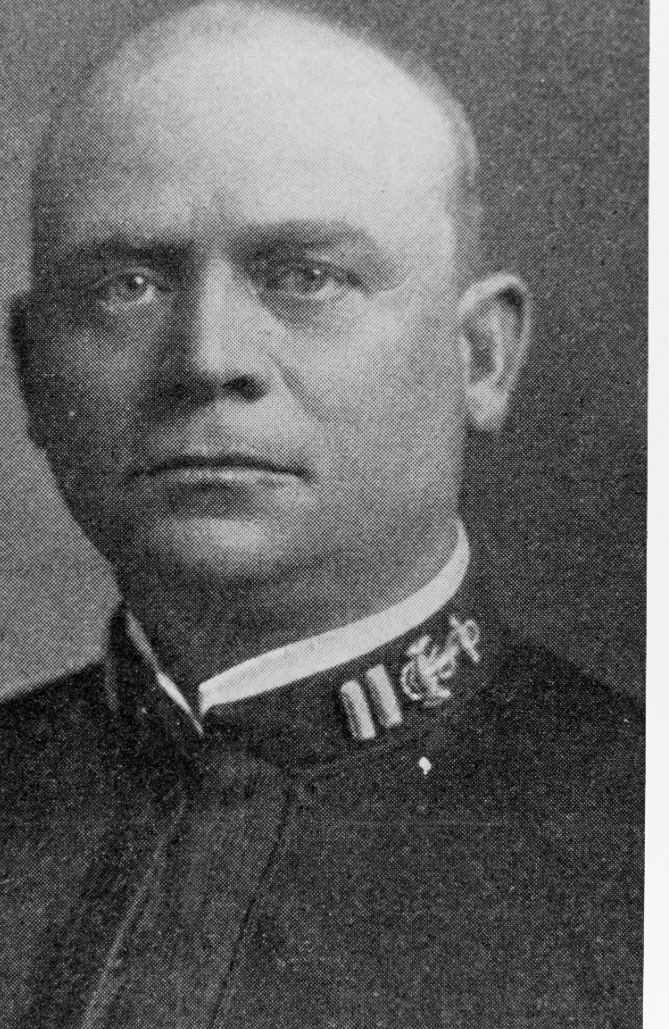
With the outbreak of war with Spain, Helm, detached from the Coast Survey, received command of the gunboat Hornet, a converted yacht commissioned at New York on 12 April 1898, the same day that Helm reported for duty. During the blockade of Cuba, Hornet captured a Spanish steamer and three contraband schooners, and for “eminent and conspicuous conduct” at the Battle of Manzanillo on 30 June 1898, he was advanced five numbers in grade. After the war’s end, Helm was detached on 21 October 1898 and reported to the receiving ship Richmond on 4 November 1898.
Again after just a short tenure, Helm was detached to serve as an Inspector in the Sixteenth Lighthouse District headquartered at Memphis, Tenn., reporting on 31 December 1898. During that duty, Helm received his promotion to lieutenant commander on 19 May 1899 (dated 3 March 1899). In quick succession, Helm assumed command of two ships; the first was the gunboat Dorothea on 3 October 1900 and then the second, the patrol yacht Frolic on 25 October. After the latter command, he was transferred to Lighthouse Establishment duty under the Civil Government of the Philippine Islands on 13 March 1902 and was later named Captain of the Port, Manila, P.I., reporting for that duty on 17 November 1903. On 31 March 1904, Helm received his promotion to the rank of commander (dated 11 October 1903).
Detached from his duty as Captain of the Port on 6 August 1906, Helm’s next two assignments saw him command cruisers. The first was Baltimore (Cruiser No. 3), from 15 August 1906 and six months later, he transferred to Galveston (Cruiser No. 17) on 6 February 1907. He was then detailed to further duty with the Lighthouse Establishment on 13 September 1907 and served in that capacity until he was detached on 31 October 1908. During his detail, Helm received promotion to captain on 19 February 1908 (dated 28 January 1908).
On 1 November 1908, he reported to, and assumed command of, Idaho (Battleship No. 23). Detached from that duty on 16 October 1909, Helm then assumed command of a shore establishment, reporting as Captain of the Yard, Boston (Mass.) Navy Yard on 18 October 1909. A little over two months later, however, he received relief from that command and reported as the commanding officer of the receiving ship Wabash on 31 December 1909. Helm served for just under a year on board, when he detached on 5 December 1910 to become Commandant, Naval Station New Orleans (La.). With the station’s closure on 30 September 1911, Helm reported to the Commander-in-Chief, Atlantic Fleet for General Court Martial duty. Having completed that assignment on 7 October 1911, Helm reported to duty as Commandant, Naval Station Charleston (S.C.) and the Sixth Naval District on 12 October 1911.
Shortly thereafter he received his promotion to flag rank, to the rank of rear admiral; the first was ad interim on 14 September 1911, then he received his regular commission on 27 December 1911 (dated 14 September 1911). Rear Adm. Helm received orders to Philadelphia, Pa. where he assumed duties as Commander-in-Chief, Atlantic Reserve Fleet, on 25 November 1914. The command’s name changed to Commander Reserve Force, Atlantic Fleet, effective 19 June 1916, and on 26 June 1916, the flag of Commander Reserve Force, Atlantic Fleet transferred to Rhode Island (Battleship No. 17). Helm was then detached on 19 September 1916 in order to report to the Navy Department on 20 September 1916 as Senior Member of the Commission on the Establishment of Additional Naval Stations. On 5 February 1918, Helm was assigned additional duty as Commandant, Fourth Naval District, reporting on 9 February 1918. For his “exceptionally meritorious service in a duty of great responsibility,” Helm received the Navy Cross.
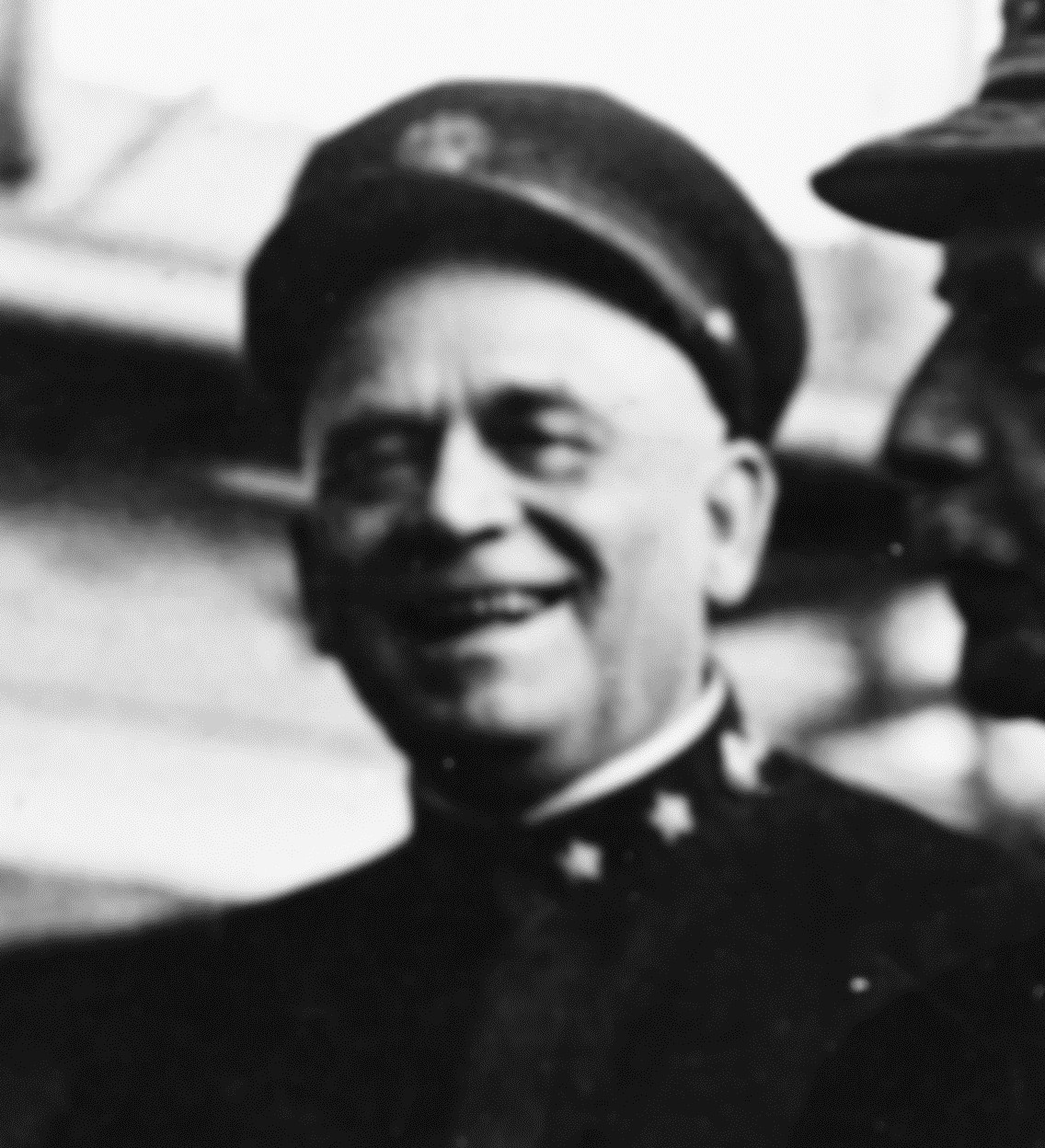
Retiring on 16 December 1919 after having attained the statutory retirement age of 64, Helm died at the Washington Sanitarium, Takoma Park, Md. on 28 October 1927. “In addition to a brilliant record at sea in war time,” a Washington, D.C. newspaper eulogized him the day after his passing, “Admiral Helm was noted as one of the world’s greatest authorities on navy yards and other naval shore stations. Many of the latter years of his service were spent in this work and he attained the highest possible commendation from his superiors for his efficient conduct and supervision of shore establishments.”
Rear Adm. Helm lies buried in Arlington [Va.] National Cemetery in Section 15, Site Lot 34.
(DD-388: displacement 1,500; length 341' 8"; beam 34' 8"; draft 9' 10"; speed 36.5 knots; complement 200; armament 4 5-inch, 4 .50-caliber machine guns, 16 21-inch torpedo tubes, 2 depth charge tracks; class Gridley)
Helm (DD-388) was laid down on 25 September 1935 at Portsmouth, Va., by the Norfolk Navy Yard; launched on 27 May 1937; and sponsored by Mrs. Edith Benham Helm, widow of the late Rear Adm. Helm.
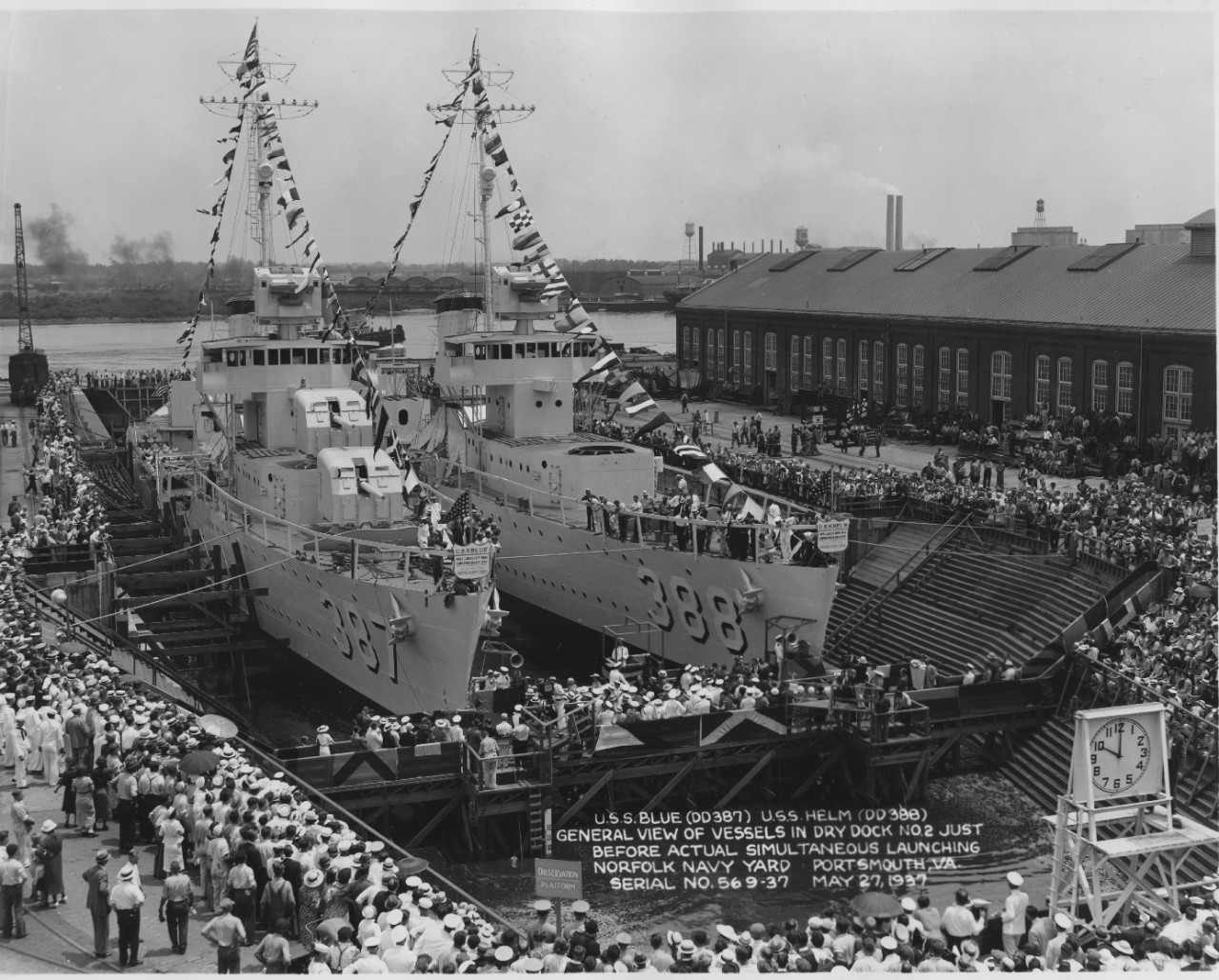
Commissioned on 16 October 1937, Lt. Cmdr. Paul H. Talbot in command, Helm conducted her shakedown cruise to the British West Indies, after which she operated in the Caribbean until March 1938.
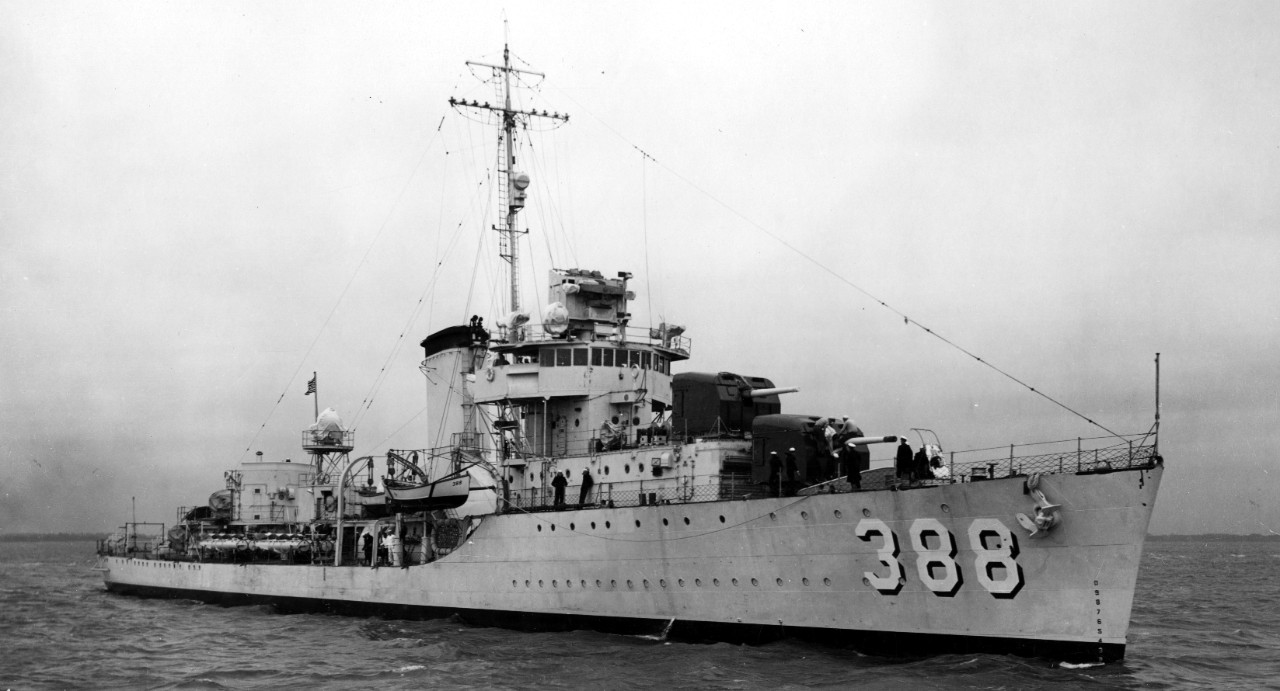
Following summer exercises, she was then attached to the newly formed Atlantic Squadron on 1 October 1938 and early in 1939, stood out of Hampton Roads in company with Enterprise (CV-6) (Rear Adm. William F. Halsey, Jr., Commander Carrier Division 2, embarked) and Yorktown (CV-5) to participate in Fleet Problem XX. After having participated in developing tactics and doctrine in that large-scale evolution, Helm transited the Panama Canal and transferred to the Pacific in May 1939 and, afterward, engaged in fleet exercises and maneuvers out of San Diego, Calif. and the Hawaiian Islands, taking part in Fleet Problem XXI. Stationed at Pearl Harbor, T.H., Helm served as a unit in the Destroyer Battle Force (DesBatFor).
On the morning of 7 December 1941, Helm was underway in West Loch Channel en route to the deperming buoys when the first wave of Japanese aircraft struck. The destroyer went to general quarters, manned her guns, and returned fire while being strafed and proceeded to the harbor’s entrance. At 0810 she shot down a Nakajima B5N2 Type 97 carrier attack plane [Kate] with her .50 caliber machine guns. At 0820 she spotted and fired upon a Japanese midget submarine near Tripod Reef. Despite not scoring any hits, her fire forced the boat to submerge. A minute later, at 0821, a torpedo passed close under the destroyer’s stern.
A Japanese plane, an orphan from one of the attacking sections of carrier bombers (Aichi D3A1 Type 99) made a glide bombing attack on Helm, dropping two 100-lb. bombs that straddled the ship. The first exploded 20 yards off the starboard bow, the second 50 yards off the port bow, the near-misses causing structural damage forward; the near miss to starboard wrinkled and dishing in hull plating and flooding forward compartments. At 1213, the destroyer joined Task Force (TF) 1 under Rear Adm. Milo F. Draemel, Commander Destroyers, Battle Force, his flag in the light cruiser Detroit (CL-8). Helm expended 90 rounds of 5-inch/38 and 350 rounds of .50 caliber ammunition during the attack. Heavy seas and high speeds, however, caused the deck plating around the gun director to be ripped, making it unsafe.
Ordered back to Pearl Harbor for repairs at 1100 on 8 December 1941, she arrived there later that night. With her repairs completed on 15 December, the destroyer got underway in the morning on 16 December as part of TF 14 formed around the carrier Saratoga (CV-3), as part of the desperate efforts to relieve Wake Island. On 23 December, however, two days before Christmas, the task force learned that Wake had fallen, a change of circumstances that compelled the abandonment of the effort. The task force returned to Pearl Harbor, arriving on 28 December. Helm and TF 14 remained in port for just a few days, getting underway on 31 December to conduct an offensive patrol in the Midway Island area.
At 1918 on 11 January 1942, Saratoga took a torpedo port side amidships from the Japanese submarine I-6. There were no submarine contacts and the screening destroyers did not conduct a search. Instead, they closed on the carrier to prevent further attacks and proceeded back to Pearl Harbor, where they arrived without incident on 13 January. Helm was then docked in the Marine Railway on 14 January for further repairs to the damage sustained on 7 December.
The destroyer then got underway in company with Selfridge (DD-357) on 20 January 1942 on a special mission to escort Hualalai and to rescue Department of the Interior workers from Howland and Baker Islands. The ships arrived at Canton Island on 27 January and departed on 29 January to execute their mission. On 31 January, Helm rescued two men from Howland Island and four men from Baker Island, civilian radio operators and weather observers, using her motor whaleboat. Destruction of the installations on those islands proved unnecessary as they had already been destroyed by Japanese bombers and submarines. At 1157 that same day, a Japanese flying boat from the Yokohama Kokutai made three horizontal bombing runs from 1,000 feet, dropping three 500 lb. bombs. Helm’s 5-inch fire on the bomber’s third run damaged the aircraft and caused it to clear the area, jettisoning its remaining three bombs. The ship expended 184 5-inch rounds and 2,500 .50 caliber rounds during the attack. The destroyer rendezvoused with Selfridge and Hualalai on 4 February and returned to Pearl Harbor on 6 February.
Helm departed Pearl Harbor on 9 February 1942 in a convoy bound for San Francisco, Calif., arriving on 16 February. She underwent an overhaul at Mare Island Navy Yard (17-27 February) and then got underway on 28 February for a return to Pearl Harbor, reaching her destination on 12 March.
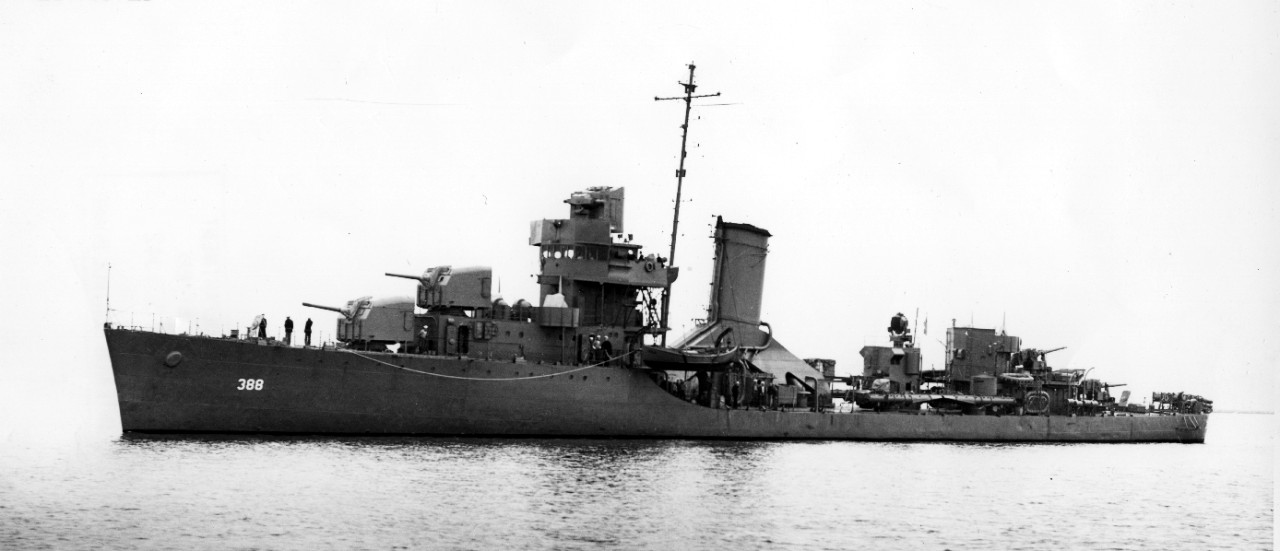
She then got underway as part of TF 13 on 15 March 1942 for Tongatabu, Tonga, in order to establish an advance operating base on the Polynesian island. While en route, however, the destination changed on 19 March, to Efate, New Hebrides. The task force arrived on 29 March. Several days later, on 3 April, Helm departed Efate to escort the oiler Cuyama (AO-3) to Noumea, New Caledonia, where they arrived on 5 April.
Both ships then left on the 6th for Tongatabu, where they arrived on 9 April 1942 and then left the next day, 10 April, for Pago Pago, Samoa. Arriving on 12 April, Helm remained until 15 April, when she was dispatched to escort Dobbin (AD-3) to Tongatabu, where they arrived on 17 April. The next day, she departed for Pago Pago, reaching that place on 20 April. The destroyer then joined Task Group (TG) 12.2, under the Officer-in-Tactical-Command (OTC) on board the light cruiser HMNZS Leander (75), to escort a convoy from Pago Pago to Efate on 1 May, arriving at Fila Harbor, Efate, on 4 May. The destroyer detached from TG 12.2 on 7 May and transferred to the newly-formed Seventh Fleet. She left bound for Noumea on 8 May. While en route, she rescued 13 survivors of the sunken U.S. freighter John Adams, torpedoed 150 miles southwest of Noumea on 5 May by the Japanese submarine I-21, on the 9th, then returned to Noumea on 10 May.
Helm departed on 14 May 1942 with orders to proceed to the Coral Sea to search for survivors of the oiler Neosho (AO-23), attacked and set ablaze by Japanese aircraft on 7 May during the Battle of the Coral Sea. The battered oiler managed to stay afloat until located by Henley (DD-391), which rescued her survivors and then scuttled her with gunfire. On 17 May, Helm came across Sea2c William A. Smith; Thaddeus O. Tunnell, Jr.; Jackson Rolston, Jr.; and Kenneth R. Bright on a life raft. Tunnell, Rolston, and Bright had all enlisted on 8 December 1941, the latter two at Kansas City, Mo., and all had been advanced in rate on 8 April 1942, a month before the Battle of the Coral Sea. Sadly, Sea2c Bright died of his injuries later that same day. Helm, after picking up Neosho’s people, then set a course for Brisbane, Australia.
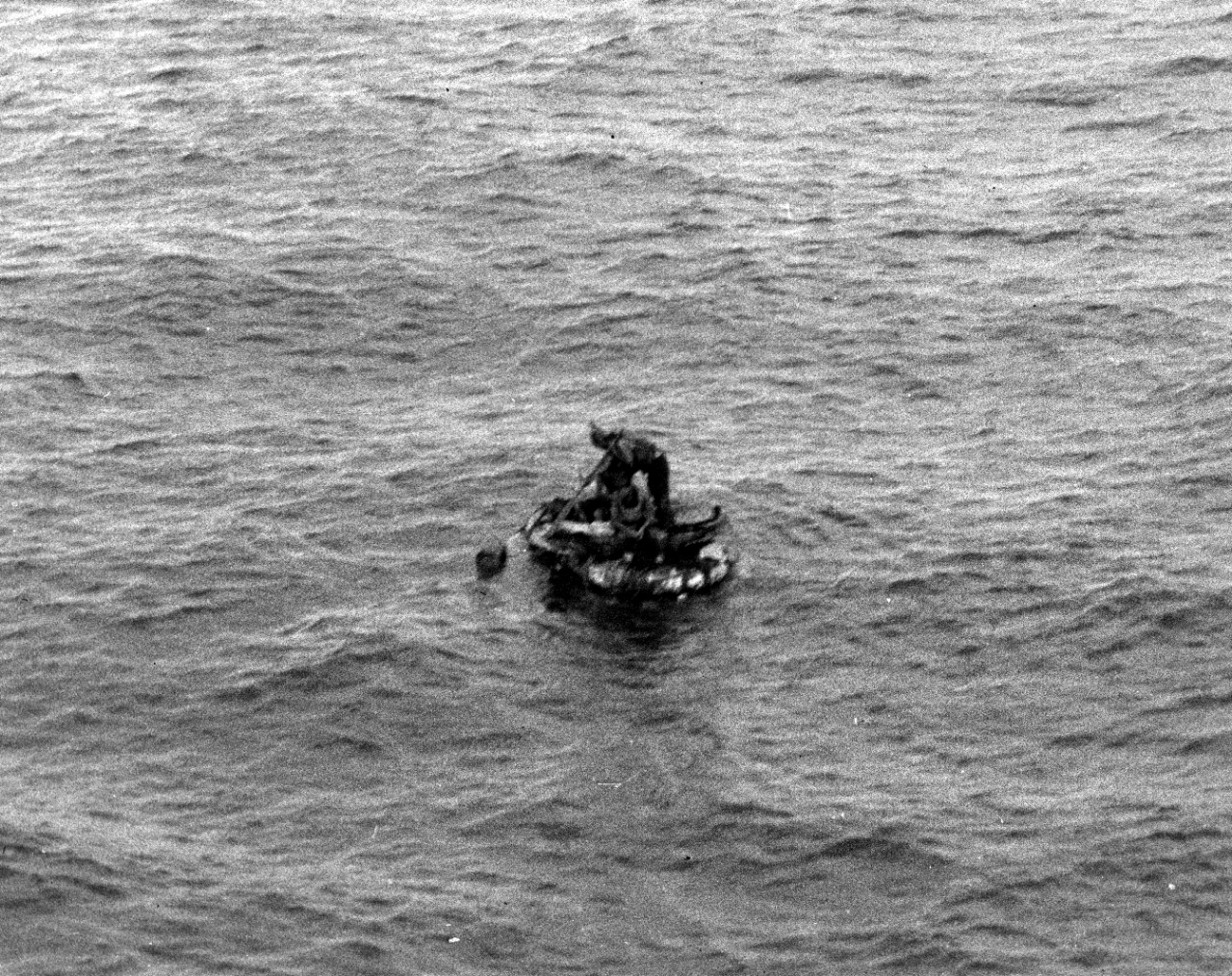
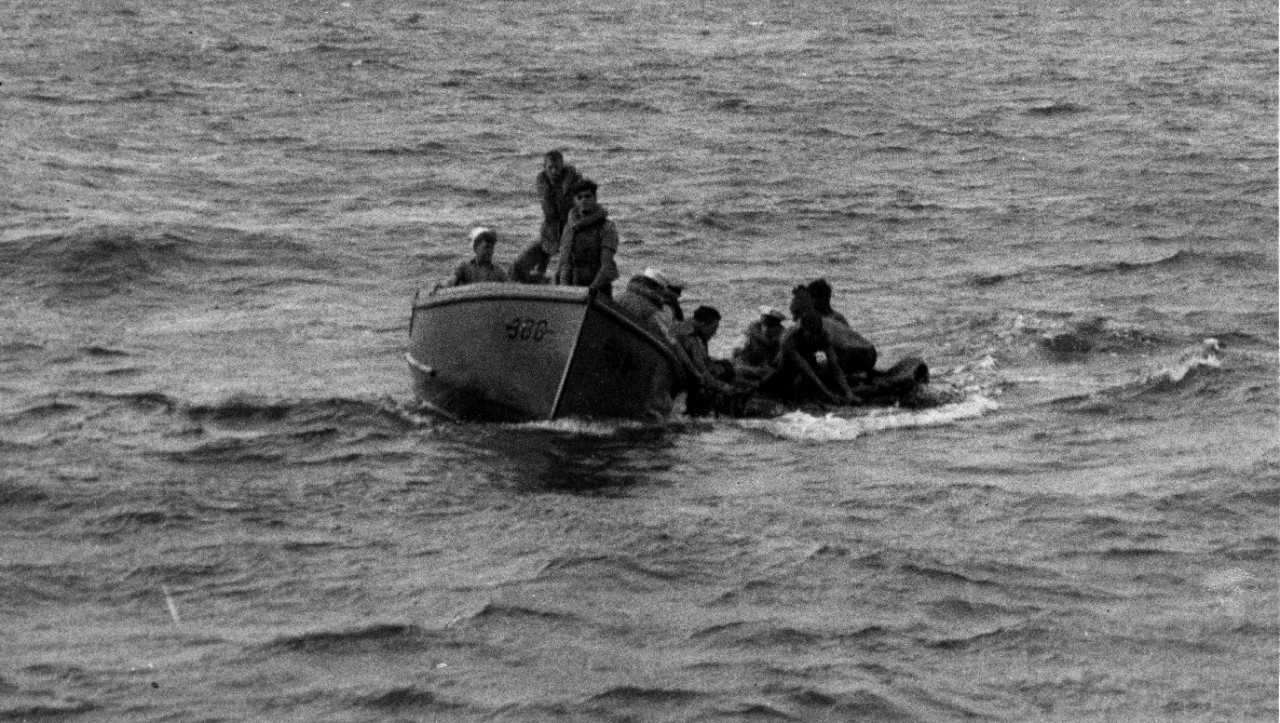
Arriving on 19 May 1942, Helm transferred the Neosho survivors ashore and then joined TF 44 under Rear Adm. Victor A. C. Crutchley, RN, his flag in the heavy cruiser HMAS Canberra (D.33). From 1 June through 4 June, Helm conducted tactical exercises and training operations with the task force. Later on 4 June, she escorted the heavy cruiser HMAS Australia (D.84) to Sydney, Australia, arriving the next day. While there, Helm underwent a tender overhaul alongside Dobbin (7-24 June). After her maintenance period, she performed escort duty along the east coast of Australia between Sydney, Brisbane, and Melbourne (26 June-16 July). On 17 July she received an order to proceed to Auckland, New Zealand, arriving on 21 July.
On 22 July 1942, Helm departed Auckland in company with Bagley (DD-386) to rendezvous with TF 62, consisting of TF 44 plus Transport Divisions (TransDivs) 8 and 10. The destroyers joined the task force on 23 July with the mission of capturing and occupying the Guadalcanal-Tulagi area in the Solomon Islands. TF 62 rendezvoused with the covering force (TF 11 and TF 18) on 26 July. The combined force rehearsed the landing at Koro Island, Fiji Islands (28-31 July) before departing for Guadalcanal on 1 August. Closing with their objective, the units formed their approach disposition on 6 August.
At 0614 on 7 August 1942, planes of the air support group opened the attack on the Guadalcanal-Tulagi area. Helm was attached to Transport Group Yoke in the Tulagi area. At 0725 the fire support group bombarded the landing beach. At 0730 landing boats arrived on the beach east of Halavo, Florida Island. At 0800 landing boats arrived at Blue Beach on Tulagi. At 1316 Helm began bombarding Hill 281 on Tulagi on orders from the heavy cruiser Chicago (CA-29). She ceased firing at 1321 having expended 106 5-inch/38 rounds. At 1322 the ship observed Transport Group Yoke in the Guadalcanal area being attacked by Japanese horizontal bombers. Two of the Japanese bombers were shot down along with one friendly fighter. At 1500 Helm observed ships in the Guadalcanal area being attacked by dive bombers.
During the night, 7-8 August 1942, Helm patrolled with the heavy cruisers Vincennes (CA-44), Quincy (CA-39), and Astoria (CA-34) in the vicinity of Savo Island. In the morning on 8 August, she returned to her transport screening station. At 1055, she received warnings of inbound enemy aircraft. All transports got underway and Helm took up station astern of Group Yoke. At 1155 she sighted 24 enemy aircraft, Mitsubishi G4M Type 1 land attack planes [Betty] with fighter escorts, approaching low over Florida Island for a torpedo attack on the transports. At 1157, Helm, the nearest ship, initiated fire on the attacking aircraft. Heavy anti-aircraft fire brought down 14 enemy planes, but Jarvis (DD-393) and George E. Elliott (AP-13) received damage. The transports returned to the loading area at 1515.
At 1800, Helm left the transport area to rejoin Vincennes, Quincy, and Astoria for night patrol east of Savo Island between it and Florida Island. Helm’s patrol speed was 10 knots and the ship changed course 90º to starboard every half hour on the half hour. Her station was 1,500 yards on the port bow of Vincennes. Wilson (DD-408) was the other screening destroyer. Another group of two cruisers and two destroyers patrolled to the south, while Blue (DD-387) and Ralph Talbot (DD-390) were stationed to the northwest of Savo. Failures in search and identification procedures had prevented early analysis of the developing situation, and the inadequate two-ship screen off Savo Island had not warned of Vice Adm. Mikawa Gunichi’s approaching Japanese cruisers and destroyers.
Patterson (DD-392) sounded the alarm around 0143, less than halfway through the mid watch, just seconds before two torpedoes ripped into HMAS Canberra (D.33) in the southern group. Soon both formations of cruisers were battling the fierce Japanese attack. At 0145 Helm observed aircraft flares and starshells to the south. A few minutes later, the force came under fire, Quincy being hit immediately. The heavy cruisers returned fire, but Helm’s point of aim was not clear and she could see no targets. The Japanese fire proved extremely accurate and soon all three cruisers were burning. Helm headed southward in the direction of the enemy intending to conduct a torpedo attack. By 0205, she made no contact with the enemy. She then received orders from Commander, Destroyer Squadron (DesRon) 4 to concentrate five miles to the northwest of Savo Island, if not in contact. She changed course to the northwest to pass north of Savo and passed through the cruiser line between Vincennes and Quincy. Both appeared to be heavily damaged, the latter stopped. Helm remained in Vincennes’ vicinity until 0220. Within ten minutes, the action was over. The destroyer proceeded to the rendezvous area and joined Selfridge, Mugford (DD-389) and Wilson.
At 0538, Helm headed back to the site of the cruiser action and she began rescuing survivors, picking up 175 officers and men from Vincennes and Quincy at 0630. At 0900, Helm and Wilson received orders to stand by Astoria which was badly damaged and dead in the water. Helm remained on station screening the cruiser until 1140 when she proceeded to Transport Area X-Ray and transferred the survivors to transport Hunter Liggett (AP-27). She then screened the transports in X-Ray until 2000, when TF 62, less detached units, withdrew from the Guadalcanal-Tulagi Area via the Lengo Channel for Noumea, arriving there on 13 August. Though the Battle of Savo Island proved a disaster, the ships lost had sold themselves dearly, for the Japanese had not reached the transports off Guadalcanal.
Helm departed Noumea on 18 August 1942, with Henley, Blue, and a convoy for Guadalcanal. On 19 August, she proceeded ahead to Espiritu Santo [Vanuatu] to screen Alhena (AK-26) which was to join the convoy on 20 August. The destroyer made the rendezvous and escorted the cargo ship into the convoy that same day. Blue and Henley left the convoy to proceed ahead on 21 August. Helm arrived at Tulagi on the 22nd to find Henley towing Blue as the latter had been torpedoed earlier that morning. Having just arrived, Helm departed Tulagi that same day via the Lengo Channel escorting Alhena to Espiritu Santo. The ships arrived on 25 August. The destroyer then departed for a return to the Solomons, escorting three district patrol vessels (former tuna boats) -- YP-239 (ex-Challenger), YP-284 (ex-Endeavor), and YP-346 (ex-Prospect) -- on 29 August, the destroyer embarking two newsmen as passengers for Guadalcanal: Tillman Durdin of the New York Times and Tom Yarborough of the Associated Press.
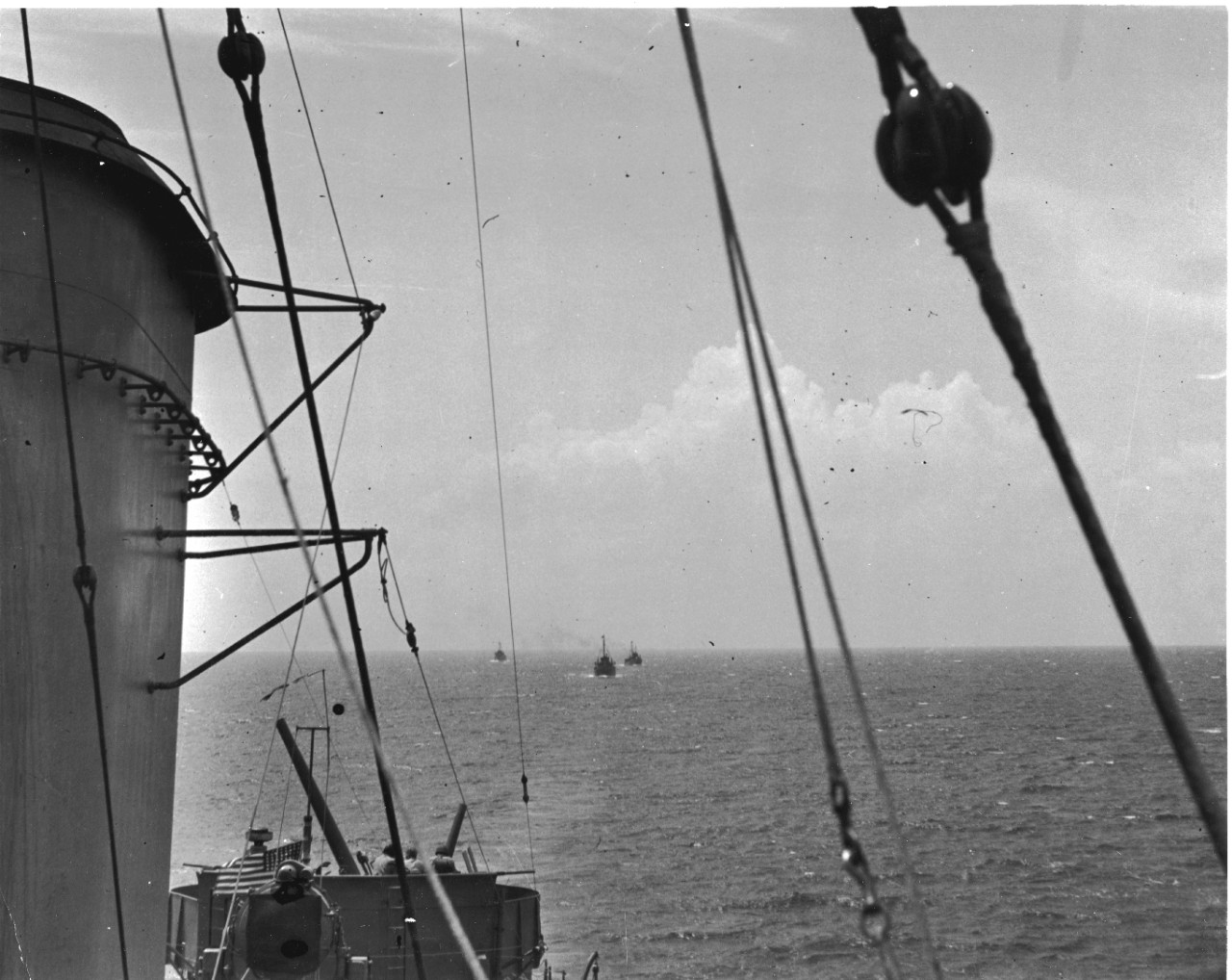
Arriving on 1 September 1942, Helm remained at Guadalcanal only a short time, departing that same day in company with Betelgeuse (AK-28). Both ships, bound for Espiritu Santo, arrived on 3 September. Helm then left in company with Henley and a convoy for Noumea. Arriving on 6 September, Helm received orders releasing her from TF 62 and directing her to move to Brisbane to rejoin TF 44. She arrived on 7 September and then left on 8 September to rendezvous with TF 44, which she did on 10 September.
At 1400 on 11 September 1942, Selfridge, Bagley, Henley, and Helm were detached from TF 44 to proceed to Milne Bay, New Guinea to intercept two Japanese destroyers. The force searched Milne Bay during the night of 11-12 September, but having made no contact with the enemy rejoined TF 44 on 12 September. From 12 September to 9 October, Helm operated as a unit of TF 44 southeast of Milne Bay, acting as part of a covering force for troop and supply movements between Australia and New Guinea, returning to Challenger Bay, Palm Islands or to Cid Harbor, Whitsunday Island, for logistics.
Detached from TF 44 on 10 October 1942, Helm proceeded to Sydney, where she arrived on 13 October for overhaul alongside Dobbin. She left Sydney on 29 October to rendezvous with submarine tender Holland (AS-3) in the Australian Bight, meeting up on 1 November, but the next day, Holland lost her rudder and had to be towed. Helm entered Melbourne on 8 November and left that same day for Brisbane. Arriving on 11 November, the destroyer left that same day to rejoin TF 44 at Cid Harbor and reached there on 13 November. She then got underway on 15 November with TF 44 acting as a covering force in the operating area southeast of Milne Bay. She proceeded to Challenger Bay for logistics on 23 November, 6 December, 20 December, and 30 December and returned to the operating area upon completion of those activities.
On 3 January 1943, Helm cleared Challenger Bay for the covering force operating area off Milne Bay, returning to Challenger Bay on 11 January, and from then until 31 January, she conducted training exercises based there and at Dunk Island. On 1 February, the destroyer got underway bound for Moreton Bay, Queensland, Australia. Arriving on 3 February, she remained two days and then departed with Bagley to escort a convoy to Noumea where they arrived without incident on 8 February. Having completed her escort duties, Helm departed that same day for Brisbane. Reaching on 10 February, she remained until 13 February when she departed for Sydney. Arriving on 16 February, she underwent a tender overhaul alongside Dobbin until 1 March when she departed for Melbourne. Arriving on 5 March, she departed the next day for Challenger Bay, where she arrived on 12 March for additional training with TF 44 in the Challenger Bay-Dunk Island area (13 March-4 April).
Helm pulled out of Challenger Bay on 5 April 1943. She arrived at Moreton Bay on 7 April and then conducted exercises with submarine Grouper (SS-214) on 8-9 April and then entered Brisbane. She weighed anchor on 11 April and returned to Challenger Bay on 13 April. From 14 April to 13 May, the destroyer again conducted training exercises with TF 44 based from Challenger Bay. She departed on 14 May bound for Sydney. Arriving on 17 May she underwent a tender overhaul alongside Dobbin. Departing Sydney on 29 May for Noumea, Helm detached from Seventh Fleet.
Arriving at Noumea on 2 June 1943, Helm was assigned to TF 10 of the Third Fleet. She departed on 6 June; rendezvousing with a tanker, the destroyer escorted her into Noumea on 9 June. The next day, Helm, in company with Mugford and Bagley, escorted a convoy to Brisbane. Upon their arrival on 14 June, Helm received orders detaching her from the Third Fleet. Re-assigned to the Seventh Fleet, she departed Brisbane on 15 June and returned to Challenger Bay two days later. In quick succession the destroyer received two new unit assignments, first she was attached to TF 74, but shortly thereafter, on 23 June, Helm received a new directive for assignment to TF 76 and departed for Townsville, Australia, arriving later that day. Along with Mugford, she departed on 26 June, to escort a convoy of tank landing ships (LST) to Woodlark Island. Arriving off Guasopa Harbor on 30 June, the embarked troops made an unopposed landing and took up positions to protect the important base at Milne Bay, New Guinea. The destroyer then departed with the LSTs the next day, 1 July, and arrived back at Townsville on 4 July. Three days later, Helm and Mugford departed Townsville escorting LSTs en route to Milne Bay via Woodlark Island. The convoy arrived at Milne Bay on 13 July.
Helm then escorted LST-457, in company with Conyngham (DD-371) and Smith (DD-378) to Kiriwina Island on 18 July 1943. She then departed for a return to Milne Bay on 21 July and reached her destination the same day. Helm moved on to Townsville on 22 July and pulled in there on 23 July. She then spent 24 July through 9 September escorting convoys shuttling between Townsville and Port Moresby, New Guinea. On 10 September the destroyer shifted to MacKay, Australia where she underwent a tender overhaul alongside Dobbin until 14 September, when she left bound for Melbourne. Arriving on 18 September, she departed on 20 September to escort a convoy to Lady Elliot Island, Australia. Helm left the convoy on 25 September and returned to Sydney on 26 September. Bound for Melbourne on 1 October, the destroyer arrived on 3 October and then departed the next day to escort a convoy to Townsville, where it arrived on 10 October. She then accompanied a convoy to Goodenough Island and returned to Milne Bay (11-16 October). Helm departed on 19 October for Brisbane. Reaching on 21 October, the destroyer then underwent overhaul (22 October-1 November).
Helm, as part of TF 74 under Rear Adm. Crutchley, departed Brisbane on 2 November 1943 and arrived at Milne Bay on 5 November. Remaining until 11 November, the ship set a course for Port Purvis, Solomon Islands and temporary duty with Third Fleet. She arrived on 13 November, remained two days, and then anchored back at Milne Bay on 17 November. Helm sortied on 26 November to rendezvous with Nashville (CL-43) and escorted her into Milne Bay on 27 November. Two days later, on 29 November, Helm, in company with Ralph Talbot and the Australian “Tribal”-class destroyers HMAS Warramunga (I.44), and HMAS Arunta (I.30) departed for an attack on Gasmata, New Britain. At 1830 the ships commenced their high speed approach to the bombardment area. Arriving on their firing course off Gasmata at 2358, they commenced their bombardment at 2400. Ceasing fire at 0021 on 30 November, Helm had expended 401 5-inch/38 rounds and then departed at high speed for Milne Bay where she arrived at 1300.
After spending much of early December 1943, escorting vessels into Milne Bay and conducting training exercises, Helm departed on 14 December with TF 74 under Rear Adm. Crutchley for the operating area in the Solomons Sea, east of Kiriwina, to serve as the covering force for the U.S. Sixth Army’s amphibious landing at Arawae, New Britain. The destroyer then returned to Milne Bay on 16 December. Just over a week later, on 24 December, TF 74 got underway in support of the amphibious landings at Cape Gloucester, New Britain. The task force crossed Huon Gulf on 25 December, Christmas Day, and proceeded north through Vitiaz Strait to Cape Gloucester. Arriving during the early morning on 26 December, the task force’s cruisers commenced bombardment of the landing beaches. Helm helped in the pre-landing bombardment, fired close support missions after the initial landings, and performed screening duties as the transports unloaded. By 0915 the fire support mission was completed and the task force retired to Buna, New Guinea on a reverse track and arrived at their destination at 1800 on 26 December. TF 74 left Buna on 27 December and patrolled northeast of Cape Gloucester on the night of 27-28 December and returning to Buna later on the 28th. Helm then left Buna on 30 December, in company with Warramunga and Arunta, as the escort to echelon B-9 to Cape Gloucester. After unloading the echelon and its escorts returned to Buna, arriving on 31 December 1943.
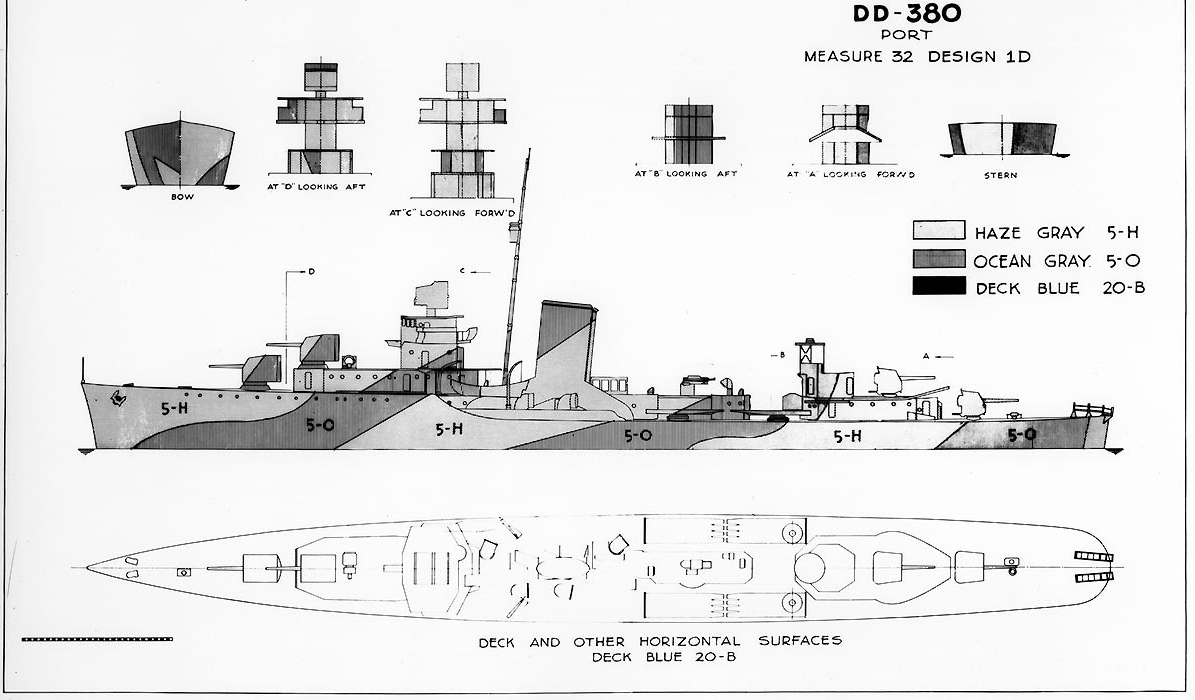
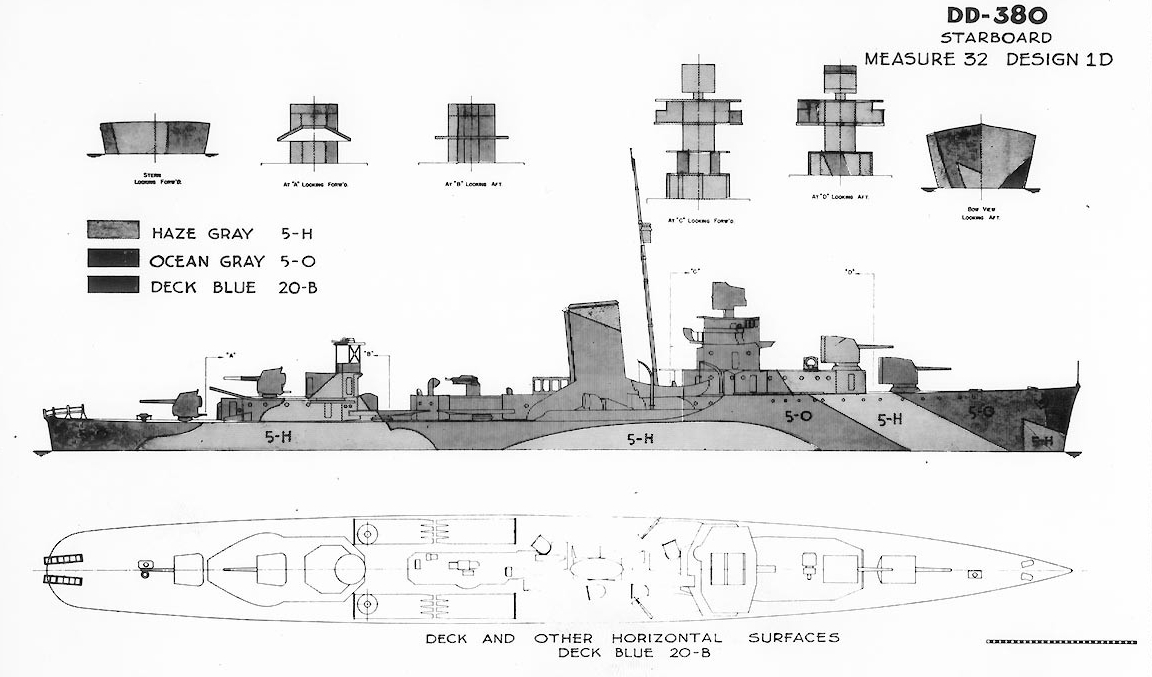
On 1 January 1944 Helm departed Buna as part of Task Unit 76.1.43 for Saidor, New Guinea to serve as a covering force for amphibious landings being conducted by units of the U.S. Sixth Army at Saidor. The task unit covered those landings on 2 January and then escorted the returning echelons to Buna, the same day. From 3 January to 3 February, TU 76.1.43 escorted logistics ships from Buna to Cape Gloucester and Saidor in support of each of those operations. Helm departed Buna on 4 February and arrived at Milne Bay the next day. Then on 10 February, Helm, along with Mugford, Bagley, and Ralph Talbot were relieved by DesDiv 38 in Seventh Fleet and they left Milne Bay for Port Purvis and escort duty with Third Fleet. Arriving at Port Purvis on the 12th, they left the same day for Guadalcanal. The next day, 13 February, Helm and Mugford left Guadalcanal as escorts for a convoy to the halfway point to Pearl Harbor. Leaving the convoy on 19 February, both escorts proceeded to Pearl Harbor. Arriving on 24 February, they left the next day as the escorts for Maryland (BB-46), setting course for the Pacific Northwest, to the Puget Sound Navy Yard, Bremerton, Washington. Having made the transit with the battleship without incident, the destroyers were detached on 3 March and headed to Mare Island Navy Yard, Vallejo, Calif., where they arrived the next day. Helm then underwent overhaul (5 March-4 May). With her maintenance period completed, Helm left San Francisco, Calif., as part of TG 12.2 on 5 May, arriving at Pearl on 10 May. She then underwent additional repairs and refresher training (11-28 May), before departing for Majuro with TG 12.5, assigned to DesDiv 11 in DesRon 6.
Helm arrived at Majuro on 4 June 1944, then departed on 6 June with DesDiv 11 escorting the heavy cruiser Louisville (CA-28) to Kwajalein, Marshall Islands, arriving on 7 June. Leaving the same day, the destroyer rendezvoused with TG 58.1 en route to supporting amphibious operations against the Japanese-held Marianas Islands of Saipan, Tinian, and Guam. Helm operated in the Marianas from 11-13 June, then with Hornet (CV-12) steamed north to attack the Bonin Islands on 15-16 June. On 18 June they rendezvoused and rejoined TF 58 in preparation for a fleet engagement. From 0937 to 1500 on 19 June, TF 58, commanded by Vice Adm. Marc A. Mitscher, endured attacks from Japanese carrier-based aircraft as part of the opening phase of the Battle of the Philippine Sea (19-20 June). Helm steamed west on 20 June and the carriers launched attack groups at 1700 to strike the retiring Japanese fleet in the second phase of the battle. The carriers recovered those returning aircraft around 2130 the same day.
On 21 June 1944, Helm steamed northeast as part of the attack on Pagan Island on 23 June and Iwo Jima on 24 June. Late on the 24th, the destroyer left TG 58.1 with McCall (DD-400) to escort Baltimore (CA-68) to Eniwetok, Marshall Islands. They arrived on 27 June, as did TG 58.1. Helm, as part of TG 58.1, sortied from Eniwetok on 30 June en route to the Bonin Islands area in order to provide air support for the landings on Guam and the neutralization of Japanese bases in the central Pacific. The carriers launched strikes against the Bonin and Volcano Islands on 4 July. The task group them steamed south the next day to the area east of Guam. From 7-21 July, TG 58.1 made daily strikes against positions on Guam. During these operations, on 9 July, Helm expended 255 5-inch/38 rounds bombarding Japanese positions on Orote Peninsula, Guam, with Oakland (CL-95). On 23 July TG 58.1 joined other groups of TF 58 in leaving the Marianas to launch strikes against Yap, Palau, and Woleai. TG 58.1’s aircraft made strikes against Yap on 25-26 July. The task group then retired toward Saipan on 27 July, arriving on 1 August to rearm the carriers.
Helm departed Saipan on 2 August 1944 with TG 58.1 en route to the Bonin Islands. Carrier planes struck at targets in the Bonin and Volcano Islands on 4-5 August. On the latter day, DesDiv 11 (including Helm) transferred to TG 58.3. They then left the Bonins area for Eniwetok, reaching on 9 August. While at Eniwetok, DesDiv 11 transferred to TG 58.4. The destroyer then sortied from Eniwetok as part of the task group on 28 August en route to the Bonins to neutralize the Japanese bases there. Carrier aircraft struck at targets on the Bonin and Volcano Islands from 31 August through 2 September. Meanwhile, DesDiv 11, Biloxi (CL-80), and New Orleans (CA-32) separated from TG 58.4 to bombard targets on Chichi Jima. On 1 September the task group transferred from Fifth Fleet to Third Fleet and saw its designation changed to TG 38.4. Helm and the division screened Biloxi and New Orleans as the cruisers bombarded Chichi Jima from 0850 to 1040 on 1 September. Afterward the bombardment group rejoined the rest of the task group.
Early the next day, 2 September 1944, units from the task group broke off to bombard Iwo Jima. At 0615 that day, Helm sank a small Japanese merchantman near Kita Iwo Jima with 95 rounds of 5-inch/38 caliber and later that day, at 1202, surprised and sank a small Japanese cargo ship near the south shore of Iwo Jima with 78 rounds of 5-inch/38 caliber. The bombardment then commenced firing on their assigned targets. Helm bombarded from 1203 to 1313 expending 283 rounds. At 1318 the bombardment ended and the ships returned to and rejoined TG 38.4. They then departed the Bonins for Saipan, reaching it on 4 September. The next day the task group departed to bombard Yap. Carrier planes struck Yap from 6 through 9 September and then shifted to the Palau Islands (10-18 September) covering the landings on Peleliu and Angaur. TG 38.4 then departed the Palau area on 18 September for Seeadler Harbor, Admiralty Islands. Arriving on 21 September, the task group sortied again on 28 September and to 6 October operated in the Palau area providing close air support (CAS) for ground operations.
TG 38.4 rendezvoused with the other groups of TF 38 on 7 October. Their mission was to strike enemy targets on Okinawa, Formosa (Taiwan), and northern Luzon in the Philippines. After a high speed approach, the carriers launched strikes against Okinawa on 10 October, retiring the same day. The next day, the aircraft attacked Luzon followed by strikes on Formosa on 12-13 October. Helm expended 58 5-inch/38 caliber rounds bringing down one Japanese Mitsubishi G4M Type 1 land attack plane [Betty] on 13 October. The task group then shifted to an operating area east of Luzon, from which it launched carrier strikes against Luzon (14-23 October). The task group initiated the Battle of Leyte Gulf on 24 October by attacking Japanese warships in the Mindanao Sea and south of Mindoro Island. The task group then set a course for the San Bernardino Strait that night. At 2114 the group received reports that a Japanese carrier task force was sighted northeast of Luzon. The TG 38.4 changed course to reunite with TF 38. On 25 October carrier planes from 38.4 and other groups destroyed the Japanese carrier force. The next day, 26 October, the task group returned to operating in the area off Samar and provided support to ground operations on Leyte (27-31 October). At 1228 on 28 October, Helm made contact with what was most likely the Japanese submarine I-46 (Lt. Comdr. Yamaguchi Kosaburo) and, assisted by Gridley and a Grumman TBF Avenger from small carrier Belleau Wood (CVL-24), attacked with depth charges and sank it. Upon completing the action the destroyer rejoined TG 38.4. Two days later, the Japanese did make a successful kamikaze attack on the formation on 30 October, suiciders heavily damaging Franklin (CV-13) and Belleau Wood. The destroyer subsequently retired from the area that night and set a course for Ulithi. After almost two months of continuous service, Helm reached Ulithi on 2 November.
Departing Ulithi again on 5 November 1944, Helm and her carrier group returned to the operating area east of Samar for strikes against Japanese shipping and shore targets in Ormoc Bay on 11-12 November and then concentrating on the Manila area from 13-18 November. The task group departed the Philippines on 19 November and returning to Ulithi on the 20th. Helm was then detached from TG 38.4 on 25 November and steamed from Ulithi on the 26th as part of Task Unit 30.1.5. She arrived at Seeadler Harbor on 28 November and transferred to Seventh fleet as a unit of TG 77.4 and began preparations for the next major amphibious operation in the Philippine campaign, the Luzon landings at Lingayen Gulf. The destroyer left Seeadler Harbor on 14 December for exercises and rehearsals in Huon Gulf, New Guinea, returning to Seeadler Harbor on 20 December. Helm departed on 27 December en route to the Kossol Passage as part of TG 77.4, reaching the destination on 30 December.
Helm sortied, bound for Lingayen Gulf, with the task group on 1 January 1945. The ships entered the Surigao Strait at dawn on 3 January, and as they entered the Sulu Sea at 1718 on 4 January, heavy air attacks began. The Japanese struck with kamikazes and one of the aircraft crashed through the flight deck of the escort carrier Ommaney Bay (CVE-79). The resultant fires caused her to sin, but gunfire from Helm and the other screening ships took a heavy toll of the attackers. The destroyer also rescued 93 survivors and transferred them to heavy cruiser Minneapolis (CA-36).
The next day, 5 January 1945, the task group entered the South China Sea and at 1644, general quarters sounded as the ship received reports of inbound enemy aircraft closing from the east. The U.S. combat air patrol (CAP) fighters identified the incoming “bogies” as five Nakajima Ki-43 Oscars. Two of these were shot down by the CAP before they came into range. The other three, however, broke through and made low, fast suicide attacks on screening units on the eastern side of the task group. The first of these was believed to have been shot down by Maury (DD-401) and the second crashed close aboard a high-speed transport (APD). Helm engaged the third as it attempted to crash into the ship’s bridge. Firing her 5-inch battery along with her other anti-aircraft weapons that could bear, Helm staved off the enemy fighter when a hit from her 40 millimeter projectiles sheared off the plane’s left wing and caused it to veer off course. The Oscar struck the searchlight platform and damaged a searchlight before crashing into the sea close aboard. Six men received minor injuries and one sailor blown overboard was subsequently rescued by Ralph Talbot.
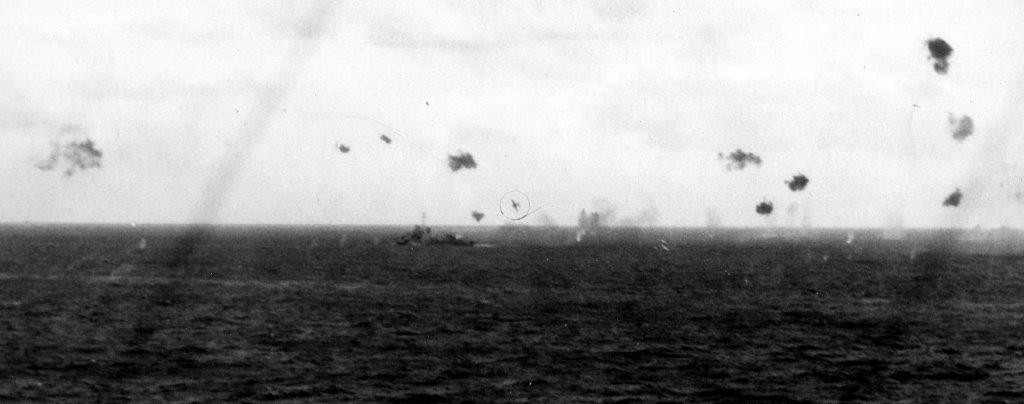
A few minutes later, six more enemy aircraft attacked the task group from the west. Manila Bay (CVE-61), Stafford (DE-411), and HMAS Australia (D.84) sustained damage when struck by kamikazes. By the end of the action, all six attackers were destroyed. From 6 January to 17 January, Helm operated west of Lingayen Gulf with the task group carriers providing air support for the landings. The ships departed on 17 January and arrived at Ulithi without incident six days later, on 23 January. Three days later, on the 26th, Helm transferred to the Fifth Fleet and TG 52.2.
On 10 February 1945, Helm sortied from Ulithi en route to Saipan as part of TG 52.2. Arriving on 12 February, the task group departed that same day for the invasion of Iwo Jima. Helm deployed in the screen for a group of escort carriers and arrived off the island on 16 February. She screened the carriers during the important preliminary strikes and protected them while they lent close air support to the invasion, which began on 19 February. The carrier groups were hit repeatedly by desperate Japanese air attacks, with Helm and the other destroyers accounting for many suicide and torpedo planes. When escort carrier Bismarck Sea (CVE-95) sank, after a kamikaze attack on 21 February, Helm, rescued survivors and brought them to the transport anchorage the next day and transferred them to the attack transports Highlands (APA-119) and Dickens (APA-161). The destroyer then rejoined TG 52.2 that evening and continued screening operations.
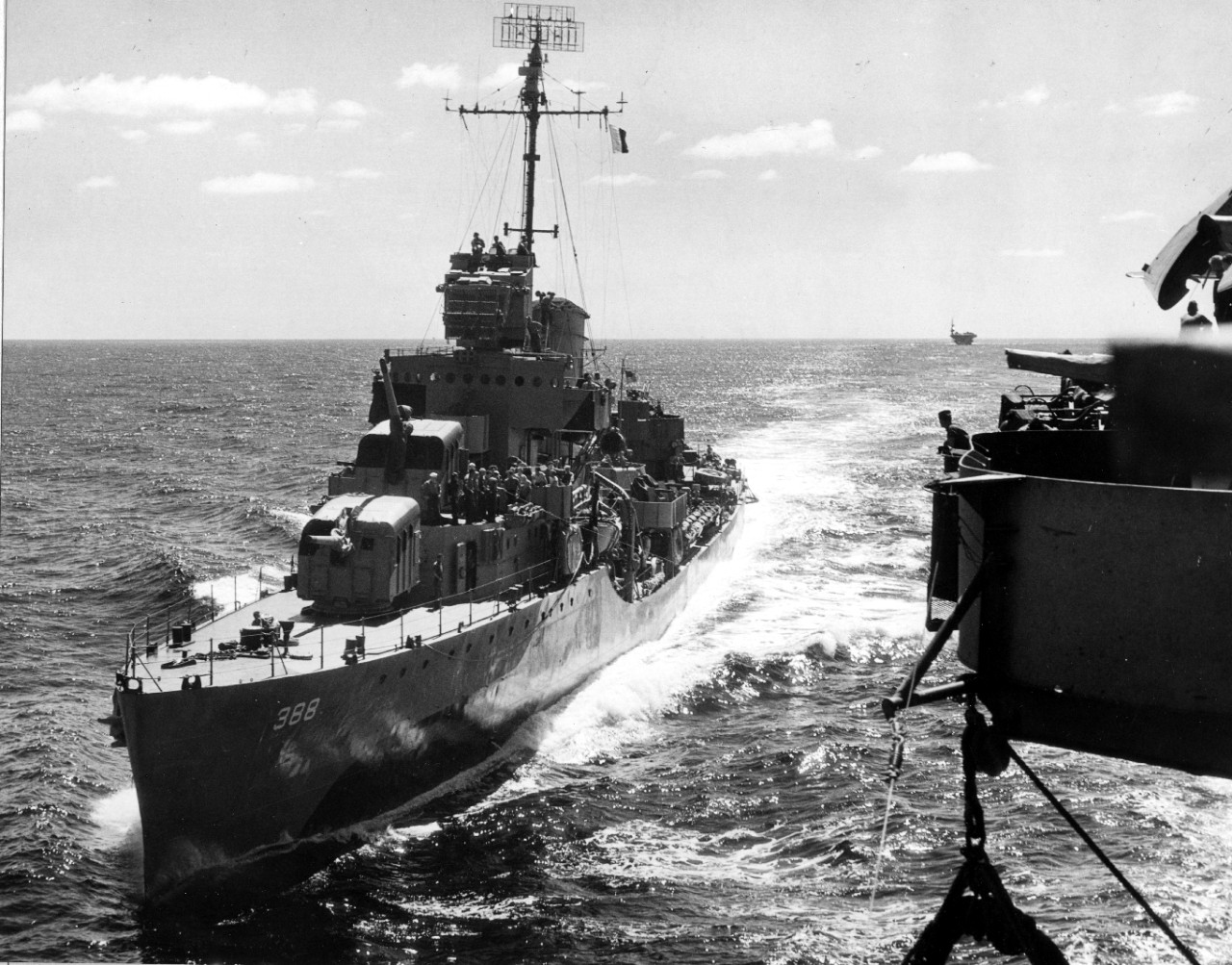
On 4 March 1945 Helm departed TU 52.2.1 to obtain rocket ammunition from Lakewood Victory (AK-236) at Iwo Jima and then rejoined the group the following day and delivered the rockets to the carriers. Steamer Bay (CVE-87), Edmonds (DE-406), and Helm detached from TU 52.2.1 on 7 March and rendezvoused with TU 50.7.1 and proceeded to Leyte for tender availability and repairs. After completing her availability, Helm sortied with TU 51.13.3 on 27 March, en route to Okinawa. The task unit’s mission was to provide air cover and anti-submarine air patrols for the transports in TG 51.13 participating in the invasion. On 1 April, Helm escorted Steamer Bay and joined TU 52.1.1 as part of TG 52.1. The force’s carrier planes made air strikes against targets on Okinawa in support of the U.S. Army and U.S. Marine Corps landings. After the initial assault, TG 52.1 operated in the area south of Okinawa and provided close air support for ground operations. On 4 April, Helm proceeded to Kerama Retto with Steamer Bay and Taylor (DD-468) for logistics. These ships rejoined TU 52.1.1 on 6 April and operated south of Okinawa. Helm continued to operate in this area throughout April and May. She fired upon an enemy aircraft that closed on the task unit on 28 April. A month later, on 28 May, the task unit’s designation was changed to TU 32.1.1. On 7 June, while operating in the area east of the Sakashima Islands, a kamikaze dive bomber crashed into the escort carrier Natoma Bay (CVE-62) damaging the forward edge of her flight deck. The task unit then returned to the operating area south of Okinawa the next day. With Okinawa secured, Helm detached from TU 32.1.1 on 15 June and proceeded to Leyte with various units of TU 32.3.3, reaching on 19 June.
On 1 July 1945, Helm departed Leyte in accordance with orders from Commander, Task Force (CTF) 94 to proceed independently to Saipan to operate with TU 94.7.2. She departed Saipan on 8 July escorting an Okinawa-bound convoy and arrived at Buckner Bay on 14 July. The next day, she departed for a return to Saipan escorting another convoy and pulled in at her destination on 22 July. In company with Mugford, Helm departed en route to Ulithi to perform escort and patrol duties. Both ships reached the atoll on 31 July. Helm patrolled Radar Picket Station Able-6, when at 1645 on 3 August; she received orders to proceed to Lat. 11º 42' N, Long. 133º 20' E and assist in the search for survivors of a sunken ship, later identified as Indianapolis (CA-35).
Helm proceeded at 26 knots to the reference position, arrived at 0710, and reported to Madison (DD-425) for duty. Helm was directed to conduct a search in Area 2, Lat. 12º 06' N, Long. 133º 46' E at 0840 on 4 August and started the search at 12 knots. A search aircraft, call sign “Playmate 2”, assisted the search. There were negative results -- no sign of wreckage, oil, bodies, or survivors or any other indication of a sunken ship. Helm gained an underwater sound contact at 1955 in position Lat. 12º 13' N, Long. 133º 50' E and proceeded to attack, dropping five depth charges. After making no further sonar contact after 40 minutes of anti-submarine operations, the destroyer resumed the search for survivors. At 0230 on 5 August, she received orders to proceed to Lat. 11º 01' N, Long. 133º 55' E to arrive at 0630. The search ships received orders to form a scouting line (axis 108º T, interval 8 miles) and conducted a search on a course of 18º T, speed 14 knots for a distance of 90 miles. Then reversing course to the left and returning on a track four miles west of the 18º track. Helm was assigned the station as point of origin with Madison as the guide, but arrived at the point of origin at 0630, only to lose radar contact with the other search units. She then proceeded eastward to close the guide and take up the station 8-mile interval from Aylwin (DD-355). At 0650 she was 8 miles from Aylwin and assumed the search course. At 0845 the assisting search plane sighted wreckage and bodies in the water about 20 miles west of Helm. The destroyer left the scouting line and steamed at 25 knots to investigate the search plane’s report. She arrived at the debris area at 0930 and sighted approximately 100 empty 40 millimeter ammunition boxes, two yellow deflated rubber life rafts, several kapok life jackets, streaks of oil and flotsam resembling insulating material. At the same time, the plane reported bodies in the water about four miles to the west. Helm proceeded to that position and sighted many bodies in the area around Lat.11° 28' N, Long.132° 47' E. All were in extremely bad condition and had been dead for an estimated four or five days. Some had life jackets and life belts, but most had nothing. Helm recovered 28 bodies and took steps to help in identifying the remains. After examination, all the deceased were buried at sea. Helm recovered no survivors.
After clearing the search area, Helm returned to Ulithi on 6 August 1945. She then departed as a convoy escort bound for Okinawa on 8 August, arriving without incident at Buckner Bay on 12 August. The next day, Helm joined Lunga Point (CVE-94), Makin Island (CVE-93), Claxton (DD-571), and Ralph Talbot as TU 95.8.1 and got underway for a return to Ulithi. It was during this transit that the war ended on 15 August. She returned to Okinawa and finally to Iwo Jima to join the Bonins patrol, for air-sea rescue work until 8 September. The destroyer then sailed to Sasebo, Japan, where she served as shipping guide and patrol vessel until returning to Okinawa on 26 September. After another stay in Japan, the ship departed for Pearl Harbor and San Diego on 29 October.
Helm returned to San Diego on 19 November 1945, then steamed back to Pearl Harbor where she was decommissioned on 26 June 1946. Helm was used later that summer as a target ship during Operation Crossroads, the atomic tests in the Pacific.

Helm was stricken from the Naval Register on 25 February 1947 and her hulk sold to the Moore Dry Dock Co., Oakland, Calif., on 2 October 1947 for scrapping which was completed on 9 May 1948.
Helm received 11 battle stars for her World War II service.
| Commanding Officers | Dates of Command |
| Lt. Cmdr. Paul H. Talbot | 16 October 1937 – 5 June 1939 |
| Lt. Cmdr. Percival E. McDowell | 5 June 1939 – 25 June 1940 |
| Lt. Cmdr. Elmer A. Tarbutton | 25 June 1940 – 23 September 1941 |
| Lt. Cmdr. Chester E. Carroll | 23 September 1941 – 4 February 1943 |
| Cmdr. William B. Braun | 4 February 1943 – 24 November 1943 |
| Lt. Cmdr. Selby K. Santmyers | 24 November 1943 – 27 January 1945 |
| Lt. Cmdr. Albert F. Hollingsworth | 27 January 1945 – 1 September 1945 |
| Lt. Cmdr. Ernest R. Peterson | 1 September 1945 – 26 June 1946 |
Christopher B. Havern Sr.
21 September 2017


